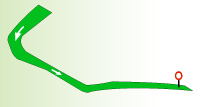Brighton Racecourse
Introduction
Brighton Racecourse is famous for its great intimacy, distinctive horseshoe shape and reputation as one of the fastest tracks in the country for sprint races. The track is one mile four furlongs long and contains an extended downhill section that rises to set-up a 100 yard level finish.
History
In 1783 a group of Brighton’s richest and most established inhabitants that included the Duke of Cumberland, Marquess of Queensbury and Earl of

Brighton Racebourse
Egremont set up the first Brighton races on an area of land called White Hawk Down which later became known as the Race Hill.
The two day event soon became a popular retreat and in only its second year attracted the presence of the Prince of Wales. In 1786 the Brighton Races were extended to four days with the first stand erected in 1788 with a capacity of 24.
The town was granted more land in 1822 by a number of local landowners, which was marked by boundary stones in 1861, some of which can still be found in the area known as the Race Ground.
With the emergence of the railway network which provided a direct link between London and Brighton the races, known for their fashionable attendees, soon attracted a lower class crowd and funding became a real issue in the 1840s. A solution was found with the establishment of the ‘Race Stand Trustees’ in 1849-50. Several improvements were made to the course as well as the erection of a new stand.
It is at this time that the current racecourse became established and in light of the investment and development the Brighton Races soon regained its former reputation.
As the racecourse grew in popularity the town’s local authority assumed full control in 1898. The First World War forced a suspension of all races between 1914 and 1917 while the stand was used an ammunition dump and food store.
The 1920s saw the return of a London influence to the Brighton Races again with a negative influence. A gang culture emerged within the racing world which often sparked fighting and unrest. This continued until June 1936 when the notorious ‘Hoxton Mob’ were arrested. This era of Brighton races has provided inspiration for the literary world with the publication of ‘Brighton Rock’ by Graham Greene in 1938 which was later adapted for the big screen.
All racing was again suspended in 1939 on the outbreak of World War II before Brighton experienced a surge in popularity that led to major re-development including the present grandstand which was opened in May 1965.
Famous Races
Brighton has played host to two world records. ‘Blink Gelding’ set the record time for the three quarters of a mile race on the 6th August 1929 on the Downhill course at Brighton while on the 26th July 1990 ‘Chase the Door’ set a mile record of 1 minute 30.9 seconds.
Race and Event Information
Brighton Racecourse has 19 confirmed fixtures between April and October 2008 including the three-day August Festival (6-8 August) which includes the John Smith’s Race Day, Ladies Day and Brighton Rocks.
All racing and event information including detailed fixtures can be found online
Travel Information
Brighton Racecourse
Freshfield Road
Brighton
East Sussex
BN2 9XZ
Brighton Racecourse is situated just a two-minute car journey from Brighton City Centre via the A27 Brighton bypass. Parking facilities are available at the racecourse and are free of charge.
If travelling by rail, services are available from London Victoria, London Bridge and London Kings Cross. A courtesy bus service operates from Brighton Station directly to the course from two hours before the first race and immediately after the final race.
Full details of how to get to Brighton Racecourse can be found online
Ticket Information
Ticket Prices
- Premier badges: £18
- Grandstand & Paddock badges: £13
- Concessionary Grandstand & Paddock badges: £9
- Admission packages from £20
- Under 16s are admitted free
Tickets can be purchased by contacting the racecourse hotline on: 01273 603 580 or by going online
